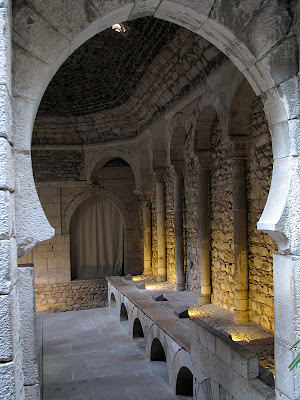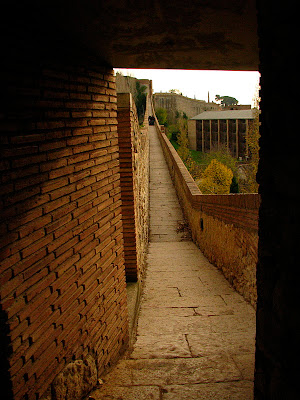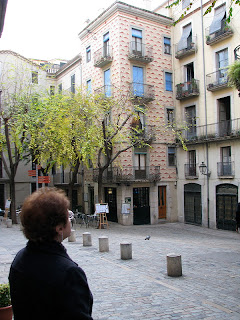While my mom was here, we had a Dali Day, a Picasso Day, and a Gaudi Day. I was most excited to finally go inside Gaudi's Sagrada Familia, as I have been eyeing it from the outside since I arrived, but it has always been too enveloped by tourist lines to think about going in. But my mom and I timed our visit just right.
The Temple Expiatori de La Sagrada Familia (Temple of the Sacred Family) takes its name from the fact that it is dedicated to Jesus and his earthly parents, Joseph and Mary. Catalan architect, Antoni Gaudi, became the chief architect of this church in 1883. He was given the commission by a conservative society that wanted to build a church as an atonement for the city's sins of modernity. This was ironic because Gaudi was the Catalan pioneer of modernisme. However, he was a deeply religious man, and felt this project's completion to be his holy mission.
This church was Gaudi's last hurrah, and consumed him as an obsession until his death in 1938. As funds ran out, he contributed his own, and in the later years of his life, he pleaded with many for contributions. It is still under construction, which makes it a unique church to visit, because it's amazingly beautiful and awe-inspiring, and there is so much more is to come!
I don't know what's more impressive, coming out of the subway and seeing the sheer verticality and strange shapes of the exterior of the church or walking inside of it, and experiencing the "forest" of pillars and stained glass light.
The pillars are shaped like trees, and support the vaults of the church. The light coming in from the stained glass windows creates a mottled lighting effect like leaves on the inside walls of the church. The tree-like branching structure was no accident; Gaudi wanted people to feel like they were inside a forest. The lighting is like no other church I have been in. There are large oculi at the top so the sky can even be seen.
"The principle of the building is to shelter us from the sunshine and rain; it imitates the tree as this shelters us from the sunshine and rain. The ramified shapes of the columns and their sheer numbers will give the congregation the feeling of truly being in a forest." - Gaudi
He studied the buds, spikes, cereals, and grasses that were growing around the site of Sagrada Familia, and then later sculpted into stone these same shapes. The pinnacles on the towers were inspired by the shapes of flower buds. I was so impressed by his knowledge of everything, from architecture, to math, to Nature, to metalwork...
The building facades on each side of the church represent a different part of Jesus' life: the Birth, the Glory, and the Passion. The Glory side is still under construction, but the Birth and Passion were explorable. On the east facade, sculpture and stained glass windows show scenes of a joyful world at the birth of Jesus.
Gaudi disliked straight lines, as there were none in Nature. He gave his towers swelling outlines inspired by the strange peaks of nearby Montserrat. Also, it's hard to see, but there is a large cypress tree up there with alabaster doves on it. It is supposed to represent a refuge in a storm for the white doves of peace.
Just like any Gothic church, gargoyles are hiding amidst the Biblical depictions to scare away evil spirits.
A turtle at the base of a pillar:
To the right of the Birth facade, is the Claustre del Roser, a tiny cloister in the Gothic style. Notice the sculpture of a reptile devil handing a terrorist a bomb. At the time this was built, Barcelona was regularly experiencing political bombings. This sculpture is built to remind people that this is one of "the temptations of men and women."
The mosaic work at the pinnacles of the towers is made from Murano glass, from Venice.
When Gaudi died in 1938, the site was entrusted to Francesc Quintana, who rebuilt the crypt and started restoring the plaster models. The inside of the church was finally finished in 2010, and this was celebrated by the Pope's visit in December of that year. It was a big deal for Catalunya.
We walked around the crypt where the architects' workspaces were visible as well as the plaster models they are working from.
On the west facade, the sculptures dramatically illustrate the events of the Passion and death of Christ. It's barren and desolate compared to the Glory side; the figures are almost inhuman in their blockiness.
This facade was built between 1954 and 1978, and is based on drawings of Gaudi. The architect, Josep Subirachs, did not attempt to imitate Gaudi's style, but created controversial images in his own unique style. I loved how it contrasted with Gaudi's floral, ornate facade of the Birth on the other side of the church.
Mmmm, lavender...
I have heard many different dates as estimated completion dates for the church, from 2020, to another 100 years. Nonetheless, it should end up looking something like this:

















































